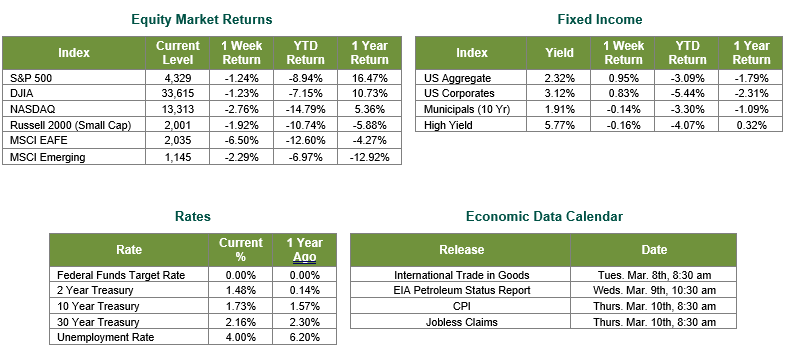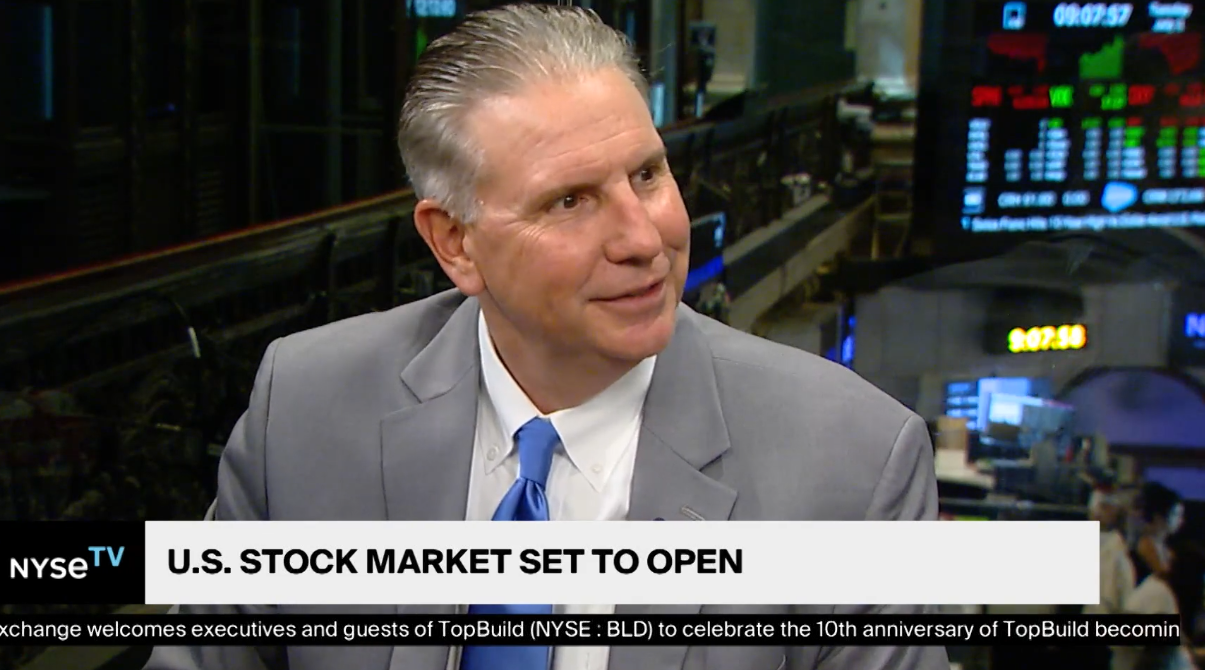
Last Week’s Markets in Review: What is Causing Market Volatility?

Global equity markets finished lower for the week. In the U.S., the S&P 500 Index closed the week at a level of 4,329, representing a loss of 1.24%, while the Russell Midcap Index moved -1.64% last week. Meanwhile, the Russell 2000 Index, a measure of the Nation’s smallest publicly traded firms, returned -1.92% over the week. International equity performance was lower as developed, and emerging markets returned -6.50% and -2.29%, respectively. Finally, the 10-year U.S. Treasury yield moved lower, closing the week at 1.73%.
Financial markets continued to experience a high degree of volatility throughout last week. The recent geopolitical events overseas have only intensified the volatility that has been a dominating factor for much of 2022. In addition to the obvious risks caused by Russia’s invasion of Ukraine, we believe the markets continue to digest uncertainties centered upon the current high level of inflation, the Federal Reserve’s plans to increase interest rates and how the U.S. economy will ultimately emerge from two years of the COVID-19 pandemic. Within this week’s Market Review, we will examine the underlying risk factors that are the origin of this persistent bout of market volatility.
Increasing levels of inflation have been a major issue through the end of 2021 and the entirety of 2022. The spike in commodity prices caused by the events in Ukraine has only made matters worse on this front. “Fed Speak” continues to suggest that supply chain issues caused by the global pandemic account for a large percentage of the current levels of inflation. If this estimation is correct, it is logical to expect less price pressure throughout the remainder of 2022 as the global economy emerges from the pandemic.
Throughout two days of testimony on Capitol Hill, Fed Chair Powell communicated the intended plan for the Federal Reserve over the near term. Within his testimony, Powell stated that the Federal Open Market Committee (FOMC) will begin a series of rate hikes with a 25 basis point move after the upcoming meeting in March. These comments confirmed that a 50 basis point hike in March is off the table, which had become a popular opinion over the past few weeks.
On Friday, the U.S. Department of Labor released the Employment Report for February. This report showed strong employment growth for the U.S. economy. Total nonfarm payroll employment rose by 678,000 in February, far exceeding the consensus estimate looking for 440,000 jobs. The unemployment rate fell to 3.8% and the labor force participation rate rose to 62.3%, both better than expected. On a negative note, average hourly earnings rose at a rate of 0.03%, far below the expected rate of increase of 0.5%.
Investors should consider all of the information and data discussed within this market. However, with so much data and so little time to digest it all, we encourage investors to work with experienced financial professionals to help process all of this information in order to build and manage the asset allocations within their portfolios consistent with their objectives, timeframe, and tolerance for risk.
Best wishes for the week ahead!
Employment data is sourced from the U.S. Department of Labor. Equity Market and Fixed Income returns are from JP Morgan as of 3/4/22. Rates and Economic Calendar Data from Bloomberg as of 3/4/22. International developed markets measured by the MSCI EAFE Index, emerging markets measured by the MSCI EM Index, U.S. Large Cap defined by the S&P 500. Sector performance is measured using the GICS methodology.
Disclosures: Past performance does not guarantee future results. We have taken this information from sources that we believe to be reliable and accurate. Hennion and Walsh cannot guarantee the accuracy of said information and cannot be held liable. You cannot invest directly in an index. Diversification can help mitigate the risk and volatility in your portfolio but does not ensure a profit or guarantee against a loss.
Diversification can help mitigate the risk and volatility in your portfolio but does not ensure a profit or guarantee against loss.
Investing in commodities is not suitable for all investors. Exposure to the commodities markets may subject an investment to greater share price volatility than an investment in traditional equity or debt securities. Investments in commodities may be affected by changes in overall market movements, commodity index volatility, changes in interest rates or factors affecting a particular industry or commodity.
Products that invest in commodities may employ more complex strategies which may expose investors to additional risks.
Investing in fixed income securities involves certain risks such as market risk if sold prior to maturity and credit risk, especially if investing in high yield bonds, which have lower ratings and are subject to greater volatility. All fixed income investments may be worth less than the original cost upon redemption or maturity. Bond Prices fluctuate inversely to changes in interest rates. Therefore, a general rise in interest rates can result in the decline of the value of your investment.
Definitions
MSCI- EAFE: The Morgan Stanley Capital International Europe, Australasia and Far East Index, a free float-adjusted market capitalization index that is designed to measure developed-market equity performance, excluding the United States and Canada.
MSCI-Emerging Markets: The Morgan Stanley Capital International Emerging Market Index, is a free float-adjusted market capitalization index that is designed to measure the performance of global emerging markets of about 25 emerging economies.
Russell 3000: The Russell 3000 measures the performance of the 3000 largest US companies based on total market capitalization and represents about 98% of the investible US Equity market.
ML BOFA US Corp Mstr [Merill Lynch US Corporate Master]: The Merrill Lynch Corporate Master Market Index is a statistical composite tracking the performance of the entire US corporate bond market over time.
ML Muni Master [Merill Lynch US Corporate Master]: The Merrill Lynch Municipal Bond Master Index is a broad measure of the municipal fixed income market.
Investors cannot directly purchase any index.
LIBOR, London Interbank Offered Rate, is the rate of interest at which banks offer to lend money to one another in the wholesale money markets in London.
The Dow Jones Industrial Average is an unweighted index of 30 “blue-chip” industrial U.S. stocks.
The S&P Midcap 400 Index is a capitalization-weighted index measuring the performance of the mid-range sector of the U.S. stock market, and represents approximately 7% of the total market value of U.S. equities. Companies in the Index fall between S&P 500 Index and the S&P SmallCap 600 Index in size: between $1-4 billion.
DJ Equity REIT Index represents all publicly traded real estate investment trusts in the Dow Jones U.S. stock universe classified as Equity REITs according to the S&P Dow Jones Indices REIT Industry Classification Hierarchy. These companies are REITs that primarily own and operate income-producing real estate.



